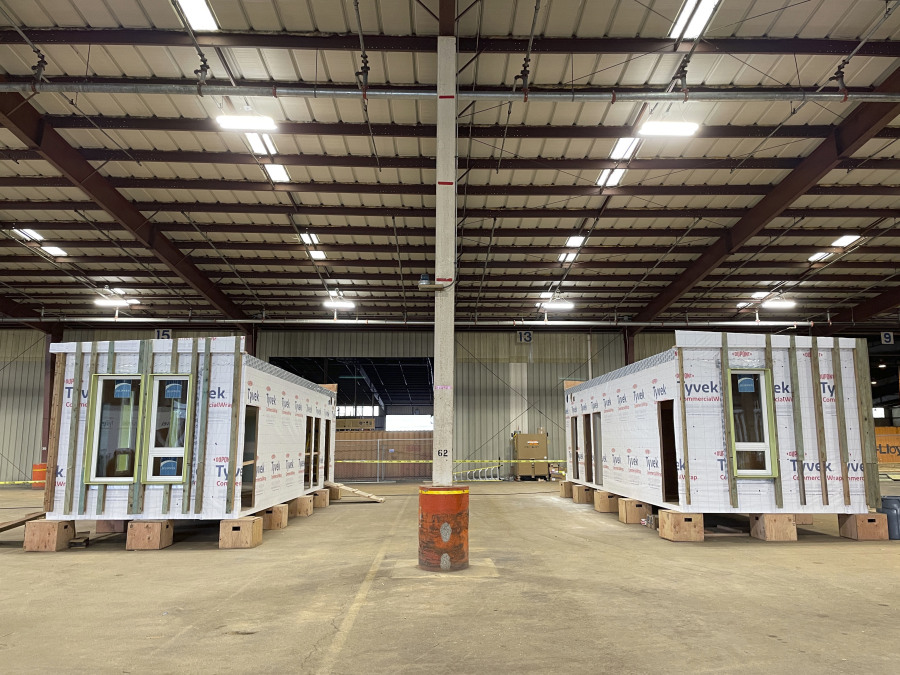BELLINGHAM — A new type of construction process using layered wood as a substitute for materials like concrete and steel that’s considered eco-friendly is becoming more popular in the U.S., especially the Pacific Northwest.
It’s called mass timber and is used especially in the construction of tall, multi-story buildings.
There have been many efforts to lower the climate cost of buildings since they account for about 13% of carbon emission in the United States, according to the U.S. Environmental Protection Agency.
While these projects reduce the operational energy of buildings, mass timber works to reduce embodied carbon and emissions caused in the construction process.
“Our building industry needs to be transformed,” Susan Jones, owner and founder of atelierjones LLC of Seattle told The Bellingham Herald in an interview. “We made a lot of amazing progress in the 20th century but I think we didn’t look at the carbon footprint on a lot of buildings and now it is time to do that. Better late than never.”
Jones’ architecture company is devoted entirely to mass timber construction, and has four buildings under construction, has built eight and designed over 20 across multiple states. She also has written the book, “Mass Timber: Design and Research.”
There are three main types of wood construction: stick frame, solid wood and mass timber:
- Stick frame, which is the standard method of wood timber construction, used traditionally in houses.
- Solid wood construction. This method is outdated, using full logs from old growth trees. Remember log cabins? This type of construction is not a common practice anymore because it was wasteful, and required cutting down some of the largest and oldest trees in the forest.
- Mass timber, which uses state-of-the-art technology to glue, nail, or dowel wood products together in layers. The results are large structural panels, posts, and beams. These exceptionally strong and versatile products are known as mass timber.
Some types of mass timber have been used for centuries in projects as a replacement to steel, this was called glue or nail laminated timber and was created by gluing and nailing parallel boards together to create posts or beams as a replacement to steel.
It wasn’t until the relatively recent invention of cross-laminated timber in 1990’s Austria that mass timber became popular in larger construction. Starting in Europe and then picking up popularity in Vancouver, Canada. Recently, mass timber has been showing up in Seattle and Portland projects.
Mass timber is amazingly fireproof
Mass timber is an umbrella term, which cross-laminated and glue/nail laminated fall under.
Cross-laminated timber is usually used as an alternative to concrete in construction, while glue/nail laminated is used in replacement of steel Rhys Faler, managing director at the Arcology Institute told The Herald in an interview.
“You can build much faster with mass timber than with any other material,” Faler said. “It is put together offsite and transported to the job site, you just gotta put it together like Lincoln Logs, you just put the pieces together and go up, up, up.”
On average, a mass timber building can save two to three months on construction when compared to steel and concrete, Jones said.
This is partly because using timber instead of concrete and steel saves weight and thus time in construction, which reduces cost and carbon emissions. Timber is also easier to produce than steel and concrete, which again reduces the financial and environmental cost.
The production benefits, combined with the carbon captured and stored in the wood itself, means mass timber construction can lower the carbon footprint of a building by 20-40%, Jones said.
“In the wood there is sequestered carbon, because wood comes from trees, and trees absorb CO2” Jones said. “When you cut down a tree, the carbon doesn’t just float away. … About 30-40% of the carbon stays in the lumber itself. It stays in 2x4s, it stays in large glue laminated columns. The bigger the pieces, when you put these wood pieces together into a panel, you are going to keep a lot of carbon captured in those.”
The carbon will stay in the lumber until the building falls down and crumbles, which is estimated to last about 150-200 years with mass timber, Jones said.
While there are some buildings in Bellingham that use mass timber to an extent, it is not very popular for a simple reason that there are not enough tall buildings in the city to justify a new method of construction, Faler said.
Although made from wood, mass timber is exceptionally fireproof. Faler said this is due to the density of the materials. The mass timber acts more like a thick tree trunk, and when the outside might get charred, it is unlikely to burn all the way through. Testing performed by the U.S. Department of Agriculture also showed that cross-laminated timber building can be fire resistant even under extreme circumstances.
One possible downside of mass timber construction is that it does require a lot of trees to be cut down, and one thing people don’t like is an increase in logging and clear-cutting.
There currently are 1,753 buildings under mass timber construction in the U.S., but according to Jones, this has not significantly impacted the amount of clear-cutting in the United States. . There is only going to be a struggle to meet demand if mass timber becomes much more popular, or if a country like China starts to adopt the practice.
“The impact of using mass timber is going to be very nominal, there are around 1,700 buildings under design or construction across the country,” Jones said.
“We anticipate that that’s growing, but it’s a blip, it’s a fractional use of the amount of wood that is already coming out of our forests.”



